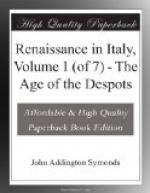It is well known that at this crisis the Emperor seriously thought of putting an end to the State of the Church. His councilors advised him to restore the Pope to his original rank of Bishop, and to make Rome again the seat of Empire.[1] But to have done this would have been impossible under the political conditions of the sixteenth century, and in the face of Christendom still Catholic. His deliberations, therefore, cost Rome the miseries of the sack; but they were speedily superseded by the determination to strengthen the Papal by means of the Imperial authority in Italy. Florence was given as a make-peace offering to the contemptible Medici; and it remains the worst shame of Clement that he used the dregs of the army that had sacked Rome for the enslavement of his mother-city.
[1] See the authorities in
Greg. Stadt Rom, vol. viii. pp.
569, 575.
Internally, the Papal State had learned by its misfortunes the necessity of a reform. Sadoleto, writing in the September of that memorable year to Clement, reminds him that the sufferings of Rome have satisfied the wrath of God, and that the way was now open for an amelioration of manners and laws.[1] No force of arms could prevent the Holy City from returning to a better life, and proving that the Christian priesthood was not a mere mockery and sham.[2] In truth the Counter-Reformation may be said to date historically from 1527.
[1] It was universally recognized in Italy that the sack of Rome was a punishment inflicted by Providence upon the godless city. Without quoting great authorities like Sadoleto or the Bishop of Fossombrone, one of whose letters gives a really awful picture of Roman profligacy (Opere di M.G. Guidiccioni, Barbera, vol. i. p. 193), we find abundant testimony to this persuasion regarding the intolerible vice of Rome, even in men devoid of moral conscience. Aretino (La Cortegiana, end of Act i. Sc. xxiii.) writes: ’Io mic redeva che il castigo, che l’ ha dato Cristo per mano degli Spagnuoli, l’avesse fatta migliore, et e piu scellerata che mai.’ Bandello (Novelle, Parte ii. xxxvii.) alluding to the sack, remarks in a parenthesis, ’benche i peccati di quella citta meritassero esser castigati.’ After adducing two such witnesses, it would weaken the case to cite Trissino or Vettori, both of whom expressed themselves with force upon the iniquities of Papal Rome.
[2] Compare Lettere de’
Princ. ii. 77; Cardinal Cajetanus,
and other testimonies quoted
by Greg. Stadt Rom, vol. viii.
pp. 568, 578.
CHAPTER VIII.
THE CHURCH AND MORALITY.




